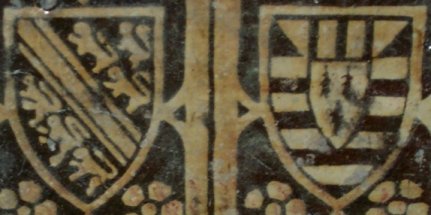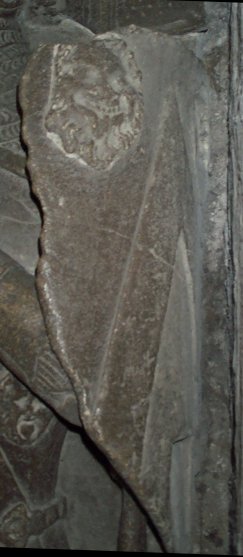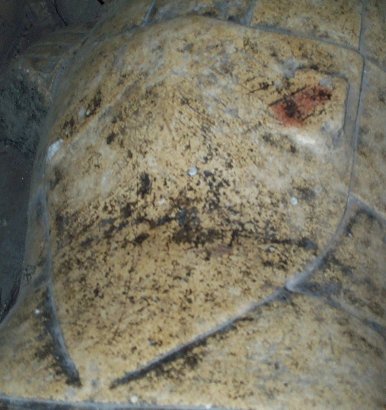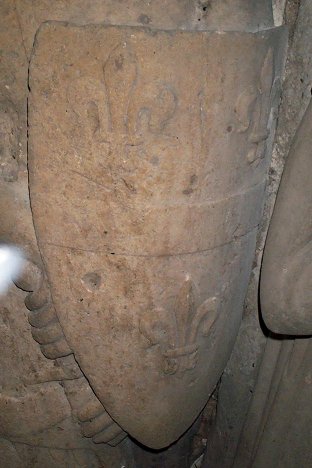Heraldry
Heraldry is an important and complex subject. As the Middle Ages
progressed knights became increasingly encased in armour and it therefore came
about that they had to be recognized solely by their colours or heraldry. The
easiest way to display a knight's heraldic devise was on his shield.
Below are two short pieces from my book, Medieval
Battles, 1055 to 1295. These succinctly describe the growth of heraldry.
The knight’s shield made a variety of
changes during our period. Initially shields were round and two early funeral
effigies in the Welsh Marches show knights with round shields (Malvern priory
and New Radnor). Eleventh century shields tended to be long kite shaped affairs
and are most commonly seen in the Bayeux tapestry. By the end of the twelfth
century the smaller so-called heater shield was commonplace and by the end of
the thirteenth century this had shrunk in size to the point where it may have
been more ceremonial than useful. As armour covered the knights more and more
the shield and cloak, now known as the surcoat, were covered in distinguishing
colours and designs as an early form of heraldry.
At Hastings it is apparent that some
form of early ‘heraldry’ was already in use, though in 1079 Robert only
recognized his father, King William I, by his voice after he had wounded him in
the arm and killed his horse. Yet at Hastings several of the knights are seen to
hold shields with emblems drawn upon them. Such emblems or devices were already
being used for recognition by the time of the battle of Brémule in 1119. After
the battle Henry I’s household knight, Ralph Rufus, was said to have changed
his arms frequently to avoid recognition. Obviously he thought it useful that
his men should know who he was in battle, but he was not so keen about his
enemies knowing. Three dismounted knights of c.1100 depicted on a pyx obviously
all have markedly different devices embossed upon their kite-shaped shields.
Quite obviously this was common form, though whether this was ‘heraldry’ as
imagined today is unlikely. Despite this early Norman development of devices,
heraldry was not used in 1136 at the siege of Exeter and as a consequence it was
noted that it was difficult in the fighting to tell friends from foes. Similarly
in Normandy in 1167, the young William Marshall, then simply a younger son, had
no heraldic arms and had to use those of Tankerville, in whose retinue he then
served. It is possible that arms were early displayed on the surcoat, but there
is no evidence of this in the early period and it may be that the knights’
colours were mainly displayed on his shield. Certainly the church effigy of Earl
William Longspey of Salisbury, cut soon after 1226, shows such a design where
colour has survived. Other church effigies show embossed shields with the coats
of arms of their owners. Good examples can be seen at Abergavenny, Gwent
[Braose, 1257], Dilwyn, Herefordshire [Talbot/Rhys Gryg, c.1274/c.1306], Boyton,
Wiltshire [Giffard, c.1280], Upper Ailey, Worcestershire [Ballon, 1289] and
Leighton, Shropshire [Leighton, c.1325-40]. The pennant on the end of a knight’s
lance would also seem to have borne his colours as early as 1217 when these
symbols were misinterpreted by the French at the battle of Lincoln. Again
confusion concerning the pennants or banners displayed by the Lord Edward and
the earl of Gloucester at the battle of Evesham in 1265 is obvious.
The point of this page, interesting though the study of heraldry
can be, is an attempt to identify various coats of arms emblazoned on monuments
throughout England and Wales. Listed below are some of these 'lost' coats of
arms. Any information on identifying these families would be gratefully
received.
 On
the left are two shields from Great Malvern priory, Bohun on the left and
Mortimer on the right. However the centre of the Mortimer shield carries
an
inescutcheon which appears to consist of three leaves. This is undoubtedly
to differentiate this Mortimer from his relations, but which Mortimer is here.
On
the left are two shields from Great Malvern priory, Bohun on the left and
Mortimer on the right. However the centre of the Mortimer shield carries
an
inescutcheon which appears to consist of three leaves. This is undoubtedly
to differentiate this Mortimer from his relations, but which Mortimer is here.
I am delighted to say that the Mortimer shield has now been
identified by Brian Timms. He states that the escutcheon has three ermine spots
and that this was borne by the Mortimers of Chirk. Therefore in all likelihood
this shield belonged to the Roger Mortimer of Chirk who died on 3 August 1326 in
the Tower of London where he was held on a charge of Treason. His son Roger died
before 1331 and his grandson John was disinherited of his Marcher estates. In
all likelihood these Bohun and Mortimer shields belong to the period 1282 to
1322 when Bohun and Mortimer of Chirk were powerful in the Marches. Earl
Humphrey Bohun fell at the battle at Boroughbridge in the same campaign that
Mortimer of Chirk was tricked into surrendering to end his days in the Tower of
London.
 A
much damaged shield showing a chevron with two lion heads at the top. The
right hand one is now hidden by a wall. This late fourteenth century
knight is in Tewkesbury abbey and probably represents a member of the Wenlock
family.
A
much damaged shield showing a chevron with two lion heads at the top. The
right hand one is now hidden by a wall. This late fourteenth century
knight is in Tewkesbury abbey and probably represents a member of the Wenlock
family.
Brian Timms reports that Micheal le Scot, died
1315, bore azure a chevron between three lion's heads or, and appears in the
Galloway Roll, GA115.
It is therefore possible that this knight was a descendant of
his.
 This fourteenth century knight at Canon Pyon, Herefordshire, was supposed to be
a Mortimer, but his coat of arms seems to be a high chevron with a roundal on
either side
This fourteenth century knight at Canon Pyon, Herefordshire, was supposed to be
a Mortimer, but his coat of arms seems to be a high chevron with a roundal on
either side
 A
shield of the late thirteenth century with three fleurs de lys and a fess from Edwin Ralph Church, Herefordshire.
A
shield of the late thirteenth century with three fleurs de lys and a fess from Edwin Ralph Church, Herefordshire.
Coming next the many coats of arms over a lady in Ledbury
church.
Copyright©1994-2003
Paul Martin Remfry
 On
the left are two shields from Great Malvern priory, Bohun on the left and
Mortimer on the right. However the centre of the Mortimer shield carries
an
inescutcheon which appears to consist of three leaves. This is undoubtedly
to differentiate this Mortimer from his relations, but which Mortimer is here.
On
the left are two shields from Great Malvern priory, Bohun on the left and
Mortimer on the right. However the centre of the Mortimer shield carries
an
inescutcheon which appears to consist of three leaves. This is undoubtedly
to differentiate this Mortimer from his relations, but which Mortimer is here.A
much damaged shield showing a chevron with two lion heads at the top. The
right hand one is now hidden by a wall. This late fourteenth century
knight is in Tewkesbury abbey and probably represents a member of the Wenlock
family.
This fourteenth century knight at Canon Pyon, Herefordshire, was supposed to be
a Mortimer, but his coat of arms seems to be a high chevron with a roundal on
either side
A
shield of the late thirteenth century with three fleurs de lys and a fess from Edwin Ralph Church, Herefordshire.